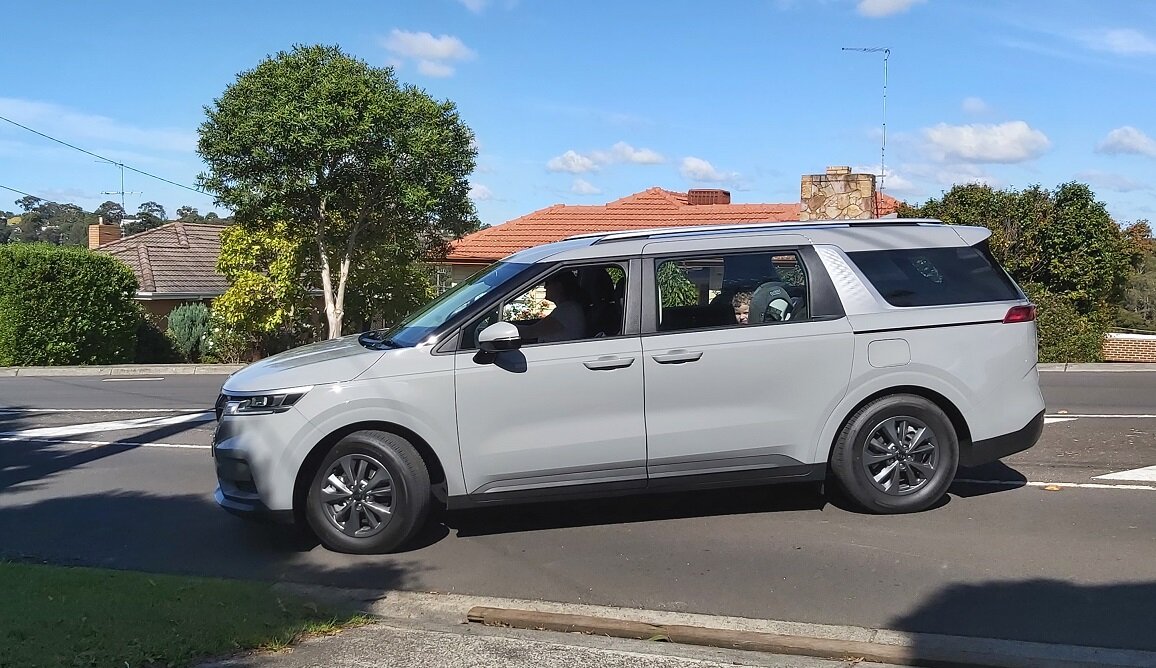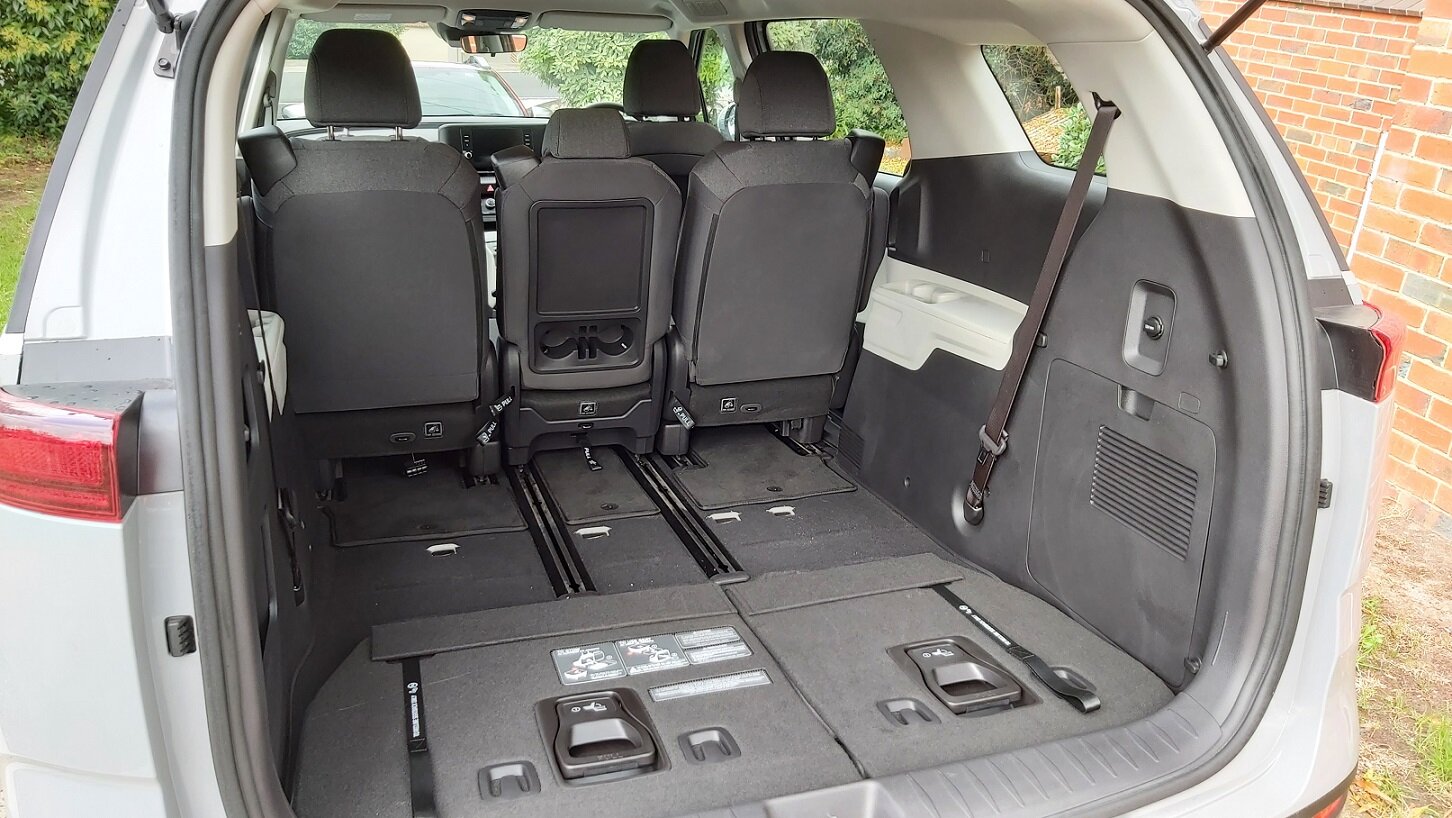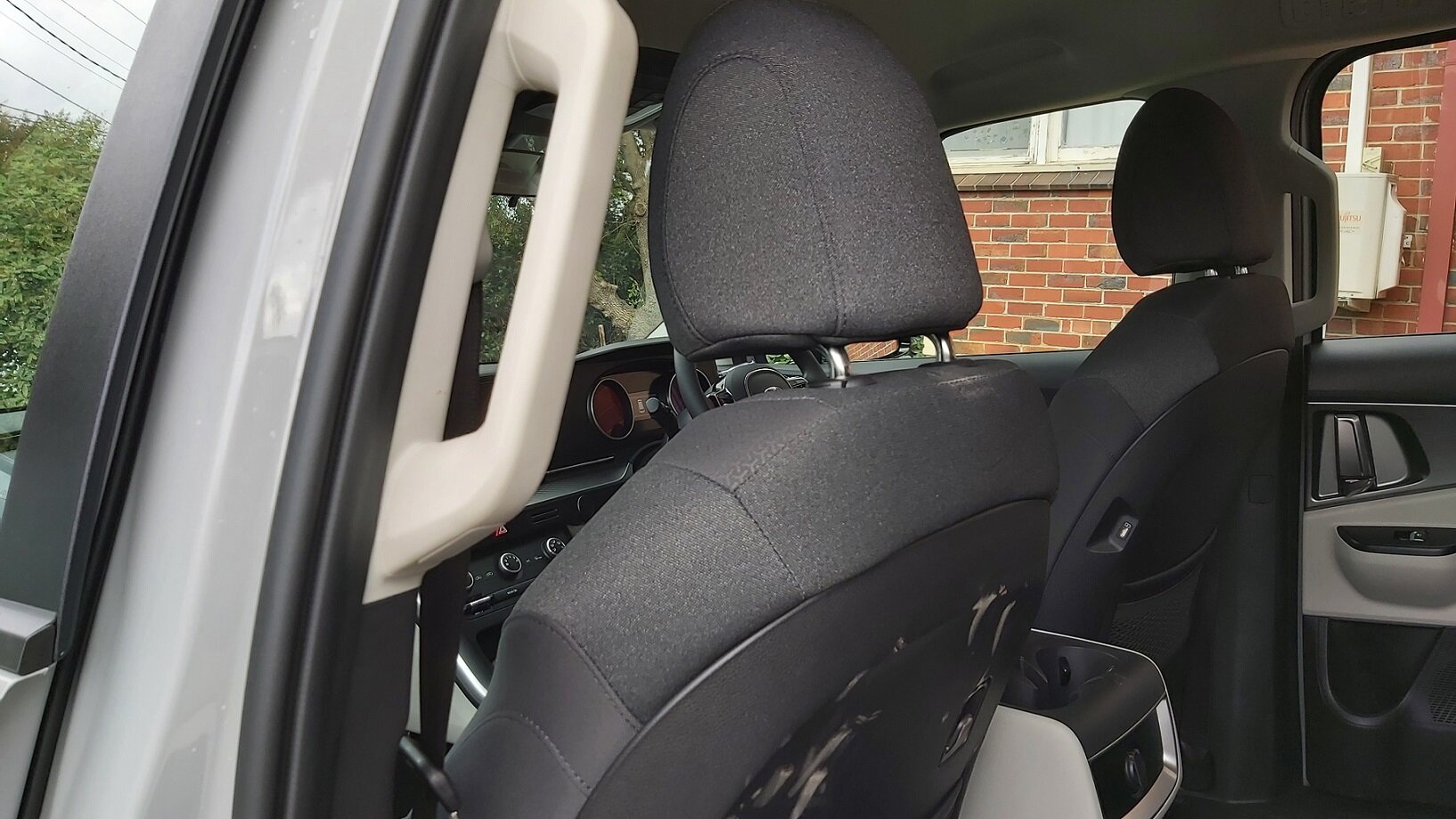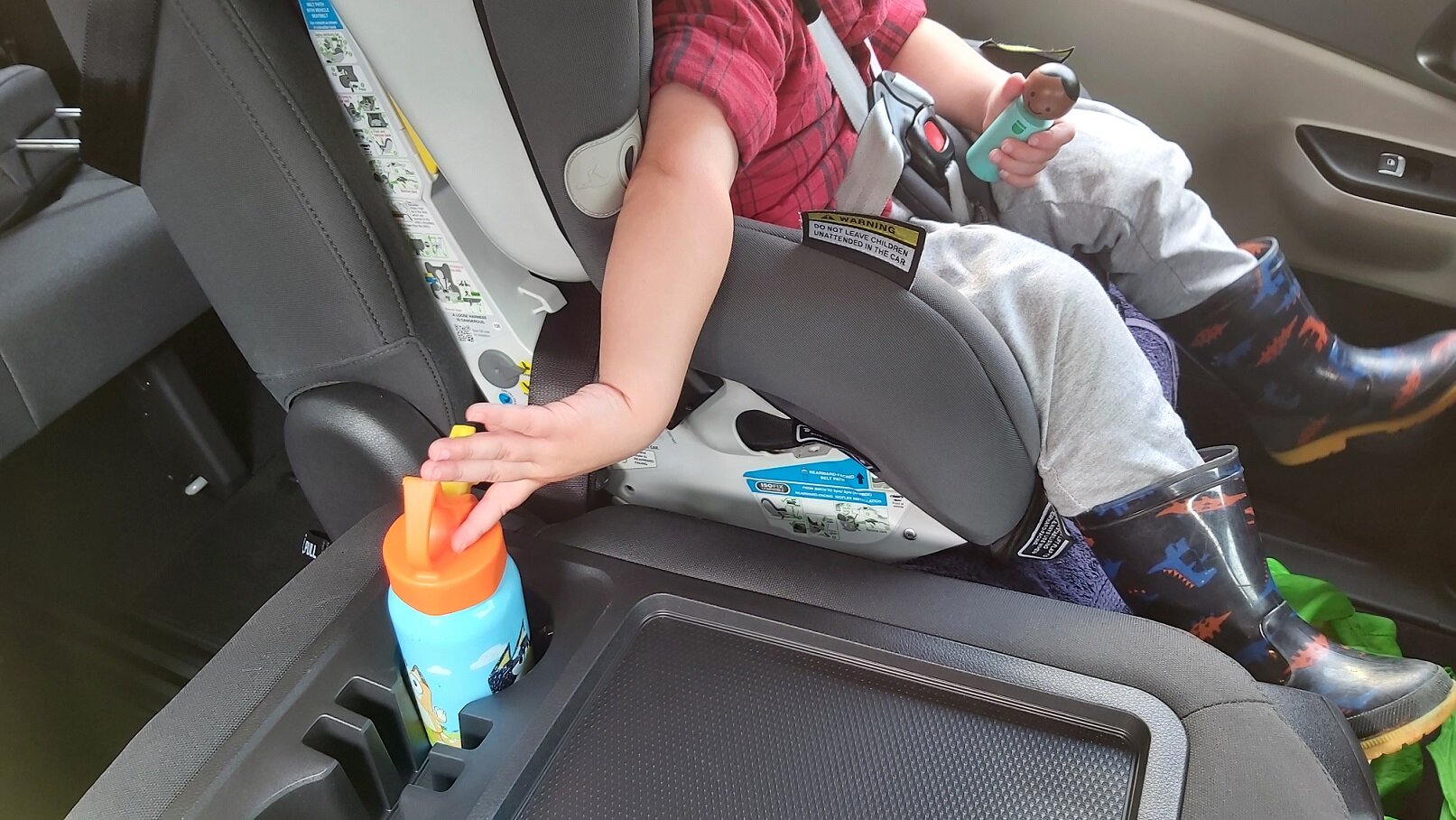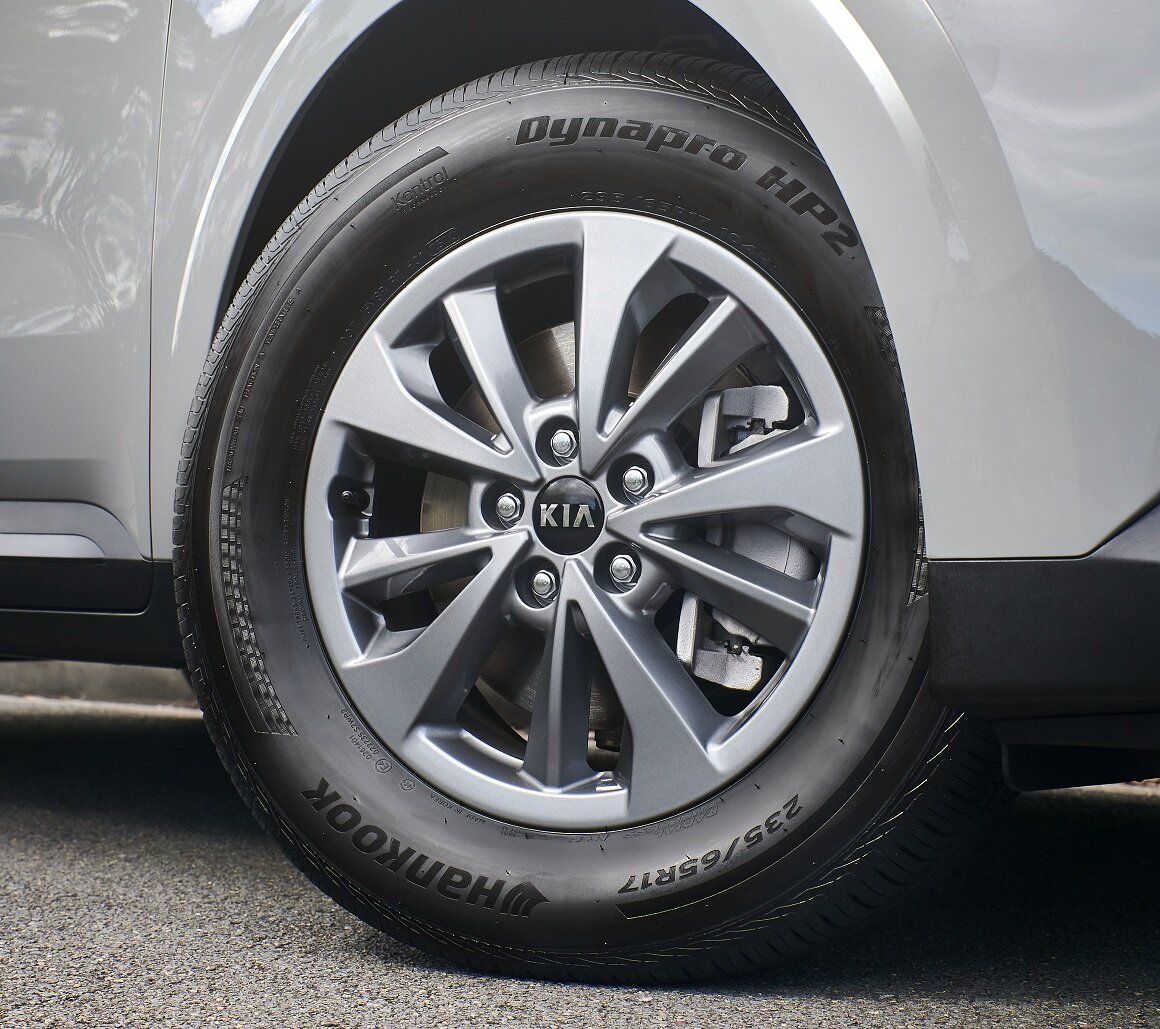Kia Carnival review and buying guide
If you've never had a people mover before, I'm going to focus most of this review on you, because you have the most to gain from opening your mind to the idea. It’s more SUV than people mover, but only on the outside.
If you've had one in the past, you already get it. You're in the club. (Hot tip: you'll love the new one.)
I drove the new Kia Carnival S base model with the diesel powertrain for a week, courtesy of Kia Australia. Driveaway it would be about $50k, which is comparatively cheap compared with the alleged value on offer in most seven-seat SUVs.
Most seven seaters start at 50K and go up to the mid-60K or even 70K, but they still don't offer the cargo space, the versatility or the configurable design of a Carnival.
Not to mention, at the end of a decent journey in a seven-seat SUV, anybody in row three is groaning and stretching when they clamber out. In Carnival, they still havr their dignity (and skeletal posture) still intact.
CX-9 is very good; Carnival is awesome.
Old Carnival was utterly brilliant; I drove it twice and each time came away impressed.
The new Carnival has officially fired a potentially fatal broadside into the SUV-fashion juggernaut.
Where you're packing carefully with a large SUV, you can simply bung it into a Carnival.
If you and your family is especially tall, this even more reason to consider one, particularly if you are tall and onto plural kids under age 10. Not only are they, typically, all using full child restraints or booster seats, but they also require additional gear like bikes, prams, school bags, and you need room for the week's shopping.
And then there are other ways in which Carnival excels at moving families from place to place, such as those occasions where someone needs a lift to or from the various weddings and funerals, the birthdays, Christmases, and family holidays. Maybe Nanna has had to many chandies, or something.
If you were to fit your Carnival with roof racks and/or a trailer, the possibilities expand even further. Think of the roadtrips and camping potential of a Carnival…
However, there is also need for some sobering clarity when it comes to all these grandiose plans.
A base model Carnival S is $50K. So you need to be certain you need all that space - and you may in fact need it, especially when I think of all those 'easy' trips down to somewhere relatively close like Phillip Island and how full our Outback is.
One diagnosis of twins at the radiologist and you need a Carnival.
And there are roughly 4500 multiple births in Australia every year, according to the Australian Bureau of Statistics.
Another part of the Carnival ownership potential is whether there is too much space. If you're sticking with two kids and you tend to book cabins and rent other people's holiday homes, you're probably gonna suffice with a mid-size or large SUV.
But again, if you haven't had the snip after Kid II, and there's a history of twins or triplets in your ancestry… Don't write Carnival off just yet.
Just touching on height again, during my recent test drive of the new Hyundai Santa Fe, I found myself talking to a random bloke in his driveway vacuuming his brand new Platinum Carnival, having stepped out of a Mitsubishi Pajero Sport. He was onto Kid IV and was exuberant over his new family bus. And he wasn't anything short of a vertically well-endowed dude. I'm average height and he had at least a foot over me.
Carnival also has great potential as a quasi tradi or moving van, and campervan.
While you can't tumble the row 2 seats forward anymore, unlike the previous version, they do still fold down into practical bench-like platform which, with a mattress and some blankets, could.make for a very clever and versatile makeshift camper not only for your budding adventurist family, but also if you're in the fleet business space and want an upmarket conveyance for your tourist/backpacker customers. A Carnival is certainly a nicer thing to look at than those disgraceful Rent-a-Bombs or Juicy campers.
And then there’s the airport transfers business who could benefit when upgrading their Hiace buses or rental companies that need to put the safest possible people mover into their whitegood fleets for customers to hire. Given that interstate travel in Australia is resuming, and even the trans-Tasman travel arrangement with New Zealand, Carnival should be up for consideration when it comes to replacing tired old models to the used market through their auction houses.
Not only does Carnival make for an excellent conveyance of you and your mates to your nearest go-karting centre to blow out the wannabe racer cobwebs (particularly after the stagnant 2020 we had), but it would also make a brilliant, er, getaway vehicle.
Not only for the slick sliding doors perfect for a Mr & Mrs Smith drive-by or car chase, and not just because all your brawny, kevlar covered mercenaries can be happily accomdated back there, but also because this prople mover is quick.
Like, if you're on it, this mum taxi can fricken hustle. In fact, you actually have to take it easy in the wet, obviously, because the front wheels can spin ever-so-briefly if you belt it from the lights during a downpour. The good thing is traction control will never let anything get out of hand. Ditto ESC if you ever need to avoid something. But it is quite fun knowing you can get the Carnival to gallop, especially in the event of overtaking, approaching steep hills or pulling out of intersections.
And it doesn’t for a moment feel bulky or boaty in the slightest. It’s quite the opposite. The on-road manners of the new Carnival are profound.
But the way it drives isn’t nearly as impressive as what you can do in the back seat. No, not like that… I mean yeah, sure, it’s your Carnival, I guess.
LARGE SUVS WORTH CONSIDERING (BUT NOT AS GOOD AS CARNIVAL):
Hyundai Palisade Review: Big, eight-seat SUVs don't glide_
Nissan Patrol Review: ‘Want’ vs ‘Need’ in a seven-seat 4X4 wagon_
Kia Sorento Review: This seven seat SUV has game_
Mitsubishi Pajero Sport Review: Not a LandCruiser and that’s okay_
PACKS A BUNCH
Let’s start from the tailgate and work out way forward, because that’s the money shot. And I’ll focus mostly on the base model S because that’s my pick of the Carnival range based purely on the practicality it offers for the price. If your budget can stretch higher to include more luxury features, then that’s entirely your prerogative, and goo on you, because the Platinum Carnival is never, ever going to feel like you’re slumming it.
Obviously, the Carnival S you see here doesn’t have a power tailgate, but that’s available in the SLi as a hands-free feature, if you really need it. Honestly, the hydraulic struts on the S an Si are good enough to manually lift the tailgate pretty easily.
Once you’ve popped the tailgate, in the words of Brennan and Dale (Step Brothers, 2008), there’s so much room for activities.
Row 3 seats stow completely flat with a sturdy, one-pull handle and retracting hinge that makes it almost completely doable with one hand. If you get the sequence and give it the right heave-ho, you can do it with one hand still holding a bag of shopping, or maybe even a kid. But the majority of mums, and most dads, probably won’t be able to do it. And this is a pity because so much of this entire vehicle is focussed on that single vision of making parenting safe and ergonomic.
Happily, you can lift up and deploy that row 3 seating with one hand. But again, it will take some practice and the main difficulty is getting the thing to lock in place, which is hard because the handle you’re using to lift the seat needs to be down in order to lock - except you’re holding the seat with the handle.
With row 3 engaged, there is a nice deep well in the rear which will hold everything from bikes or full-size travel luggage to the weekly shopping and school bags. And there’s also sufficient space at their feet in rows 2 and 3 that it may not even be necessary. The point is, you have options. You can stop in a do several errands simply because you have ample space for so many things.
If you stop at Bunnings or pick up some flat-pack furniture before getting the kids from school, you can reconfigure the second row-2 child seat into row 3 putting the kids line astern in order to fold the RHS seats of row 2 and 3 to stow your long item.
There is one annoying catch with the child seat installation of the new Carnival, which spoils the ergonomically pretty good nature overall. The top tether anchor points, on the back of each seating position - they are all fitted at the very bottom of every seatback. And I mean right…down…the bottom. So when you do need to change something around, you have to literally stand inside the vehicle, stand on the seat and bend all the way over the seat in order to clip it in.
If you have bags or something already in the footwell of row 2, you can’t really slide the seat forward to access the top tether anchor point either. With a vehicle designed to be fully operational at all times (because I can attest, the car is never empty of stuff) this can be another carpark hassle made harder by a lapse in design.
Now, in many cases, I’m sure you’ll be able to slide the seat forward and clip it in, in which case, there’s no major problem. It just would’ve been nice to see anchor points put within better reach; not all parents have the same level of flexibility as I have. Fortunately, the row 3 top tethers aren’t quite as hard to reach because the seatbacks aren’t as tall. Row 3’s ISOFIX points are also a breeze to locate and clip in, but just be aware that centre ‘seat’ space in row 3 (as the 60 part of a 60:40 split folding arrangement) is kinda cosmetic or for slender adults only, maybe a teenager or perhaps for clipping in Dog; it is strictly not suitable for kids - no tether or ISOFIX point.
ISOFIX points in both row 2 and 3 sit out and proud from the seatback, and they’re super easy to connect and yet not be in contact with your arse when you sit on it.
While we’re talking about configurability, if you go to take the headrest out in order to fit the child restraint/s, fold the seatback down first because the headrest stems are so long it hits the tapered roofline before coming out.
And when you don’t have rows 2 and 3 occupied, because the little brats are finally at school, you’ll want to make sure all headrests are stowed, particularly up the back where they are quite wide and can take up a lot of your rearview mirror.
When installing your child restraints using the top tether on rear outboard seats, make sure you get all the slack out of the straps and keep them tight. The angular design of the new seat’s shoulder area means the straps could slip over if you're not careful during installation. Obviously straps and belts should always be as tight as possible, but if you’re not particularly strong, ask for help to make sure they’re in place correctly. Square seatback shoulder areas don’t have this issue.
Quick tip: Make sure the seat has a towel gasket and the strap sits exactly over the 'collar' section of the seat back, right up against the plastic guides for the headrest stems. Routinely get in the habit of spot checking those straps so they don't creep toward the rounded shoulder of the seatback. If it does, tighten the strap hard.
For balance, Kia has been especially clever in completely integrating the outboard row 2 seatbelts into the seatbacks. This is such a triumph of ergonomic design, and one many people will overlook and underappreciate. There are fold-down armrests back there too, which will not only add a level of comfort, but as an added benefit, act as makeshift barriers to slow the kids’ progress getting out of the car in such a hurry they forget to check their surroundings. If your kids are escape artists, make sure you get those child locks engaged. Little buggers.
Your Ultimate Child Seat Installation Guide: Common mistakes and getting it right_
The doors do open and close quite smoothly, and they don’t thump into place at the rear, which is good if you have kids sleeping whom you’d like to keep that way as you transfer them into their bed.
The littlies can get in and out like big kids thanks to a relatively low door sill (unlike every single large SUV). And the joy of getting a base model without all the powered-this and push-button-that is kiddo can’t push buttons like the one in various Hyundai/Kia upper-spec models like Sorento and Santa Fe which allows you to fold or adjust the seating positions. They put that button on the seat base which is the first thing he pushes when you open the door. Now, on a press car (going back next week, I don’t really care) but if you’re gonna own this car for the next five years, maybe even 10, that button is gonna take a (literal) sugar-coated hammering.
The other benefit of having conventional pull-handles for seat adjustment is sturdiness. Not having a shot at Kia or Hyundai here, but kids have a way for destroying anything nice you ever hold valuable. They just do. Those big clunky handles are going to stand the test of time much better than some poor little button. And there’s a reason I started this review acknowledging those who haven’t bought a Carnival before - because those who have, typically have them for a long time. (I’ll come back to this point.)
Happily, my 2.5-year-old can get in and out of the Carnival easily and safely without the risk of slipping and falling headfirst into the concrete, which is something I have to be careful of in all the large SUVs he is (stubbornly) determined to scale on his own without help.
Another good-bad story in the back seats involves, again, height and reach. It’s fantastic to see grab handles on the B-pillar for kids and older people to get in and out of the nice big door aperture; it’s a little touch of added safety, especially if it’s raining or has been recently and you might have muddy/wet shoes.
But then when my fairly tall 2.5yo is in his rocket chair, even with the centre row 2 seat slid forward and the seatback folded forward to stow his Bluey drink bottle, he can’t actually reach it properly on his own. The choice to make the majority of the seatback a table space is good, even putting a lip-edge to things don’t slide around - kudos for that; but the downside is the cupholders are at the rear where many kids probably won’t be able to reach them. Then there’s the secondary factor of mum or dad needing to reach back and assist. The Carnival is gifted with so much space, average-height people like my other-half and I can’t actually reach back that far without slackening the seatbelt and reaching through the gap between the front seats, resting on the centre console. In the event of a crash, this is a bad position to be in.
I wish Kia has flipped the plastic table/cupholders section 180 degrees. Especially because the cupholders designed into the back of the centre console are also out of reach for anybody other than an average size teenager who has go-go-Gadget arms or can lean forward.
Further appreciation should go into the layout of the Carnival’s cabin, in particular, the centre instrument panel, which is simple, and uncluttered. There are no (or minimal) climate controls in the infotainment screen (which makes perfect sense). And the climate controls which are all focused in the centre are grouped nicely, they’re big buttons, surrounded by matt black trim (not bloody reflective, scratch-prone piano black!) and they are lit properly. The rocker toggles for rear temperature and fan speed are a really smart way to isolate those controls from the front, without making them hard to use. And the ‘Rear On’ and ‘Rear Lock’ buttons are also big and immediately within reach, for mum’s lightning reflexes to keep the babies comfortable.
And the storage cubby for phones, with three USB charging ports, is simple, yet inappreciably well designed. If you need to have your phone in-use for maps, you can sit yours horizontally in the cubby where it won’t fall and become a loose object. And for those who want to criticise other for not having bought a docking station for holding a phone, which you’re required to by law; in some vehicles it’s quite impractical to have a phone docked in front of an A/C vent or stuck to the windscreen obstructing your view. It is genuinely sometimes better having it sit in the dashboard for maps usage. It’s just up to the owner to not touch it while driving and pre-load the map before setting off. (Honestly, how hard is this stuff?)
The base model Carnival is better for not having all the glossy reflective trims, especially surrounding the infotainment screen, so that’s a win. And you might not have realised, but Kia has also thought of outward vision for the driver by (I guess) copying Subaru’s idea of mounting the door mirrors to the door, and not below the A-pillar.
This means you can have the small side-glass window obstruction-free, meaning you’re less likely to lose vehicles or passing objects between the fore-part of the A-pillar and where the door mirror would finish - some half a metre, depending on the vehicle. Half a metre or so of own-vehicle obstruction is quite significant when you consider the speeds you might be travelling at through some intersections, or in the country where a kangaroo might leap out. This design gives you a better chance of see that turning-out vehicle’s indicator, or spotting something to avoid, or simply making low-speed manoeuvring a little bit easier by way or glancing at those random objects like shopping trolleys, people who might step out from behind other cars are you reverse park or whatever.
NEED HELP SHOPPING FOR OR BUYING YOUR NEW FAMILY CAR?
Five best dual-cab utes for families_
Four affordable new cars for camping families_
MISSED DEMEANOUR
A great number of people on the roads today have appalling driving behaviours, from impatience and dangerous levels of aggression, to flagrant ignorance of theirs and others safety, those who are simply not present or attentive in the slightest, and those Lemmings who just follow the taillights in front from the moment they leave the driveway to their designated carpark at work.
When it comes to driving a people mover, people are probably going to make assumptions about you based purely on the fact you don’t own something smaller and allegedly faster. So, many people are probably going to drive like morons around you. They may presume you’re slow, or you’re impeding their progress somehow, just by taking your time and looking out for others’ safety, as well as your own.
This happened quite a lot during my Carnival loan period. And for transparency, this isn’t the Carnival’s fault, and I can’t say if it was because I wore a NSW rego plate in Melbourne, but on many occasions, people drove like idiots. Particularly unnerving is when you have your kids on board. So I would encourage would-be Carnival buyers to try your best to practice a patient mindset. If you’re brimming with kids, gear, scooters and prams and a partridge in a pear tree, you’re in a front-wheel drive people mover, weighing over two tonnes. You’re not going anywhere in a hurry, and you can’t do more than the speed limit anyway. So relax, take your time, keep your distance, and don’t let anybody get under your skin - you have more important things to worry about in the back seats.
Fortunately, you happen to be buying a car at a really good point in time because the safety equipment you’re gonna get on a standard Carnival in 2021 is awesome. Value today is so strong it makes buying second-hand an increasingly unnecessary exercise.
In those extremely rare moments where some malignant prick tries to overtake you 10 seconds before stopping at the next red light - and he gets it wrong - you have a long list of tech to help keep you out of the weeds and let the idiot(s) make their mistakes.
Adaptive cruise control is the key feature for me in modern cars. When you set the cruise control, it keeps you at a fixed distance from the car ahead. When you come up behind slower traffic, it keeps you at that set distance, usually measured in seconds - often two seconds from the vehicle ahead based on your current speed. If a bogey vehicle inserts itself into your two-second gap, the vehicle will slow you down to maintain that safety gap.
And you should always think of it as a ‘safety gap’ because speed is distance over time. You’re covering a certain distance in a very short period of time. If you’re always two seconds away from another car, that’s (generally, but not always) just enough time for the vehicle to bring you to an emergency stop if the car ahead of you slams on the brakes or something happens.
When driving, time - and therefore speed - is crucial to surviving and averting a crash. The more time you have, the better your chances are. Multi-car crashes on freeways or main roads always happen - and only happen - because people are travelling too close to each other, with not enough time to react and stop, or swerve.
The Carnival, and more broadly Kia’s adaptive cruise, is very good. It copes with the vast majority of situations you may encounter, and it’ll even hold your speed going down into tunnels and you’re usually pinged for stepping over the 80km/h limit. I specifically test this in the Eastlink tunnel with every press vehicle I drive. Carnival passed.
You’ve also got autonomous emergency braking (which they call ‘forward collision mitigation’), which also works in reverse and is ideal for those of you in steep or quirky driveways with places kids, the elderly and dogs can suddenly appear with zero warning.
There are lane-keeping features which help to keep the Carnival straight and between the lines on the freeway, including a partially auto-steering feature to keep you tracking correctly if you’re not putting enough angle into the steering wheel or start wandering across the lane.
Now, personally, I hate these last few features, for several reasons. Firstly, if you do want to position your vehicle off-centre in the lane, deliberately, these systems can sometimes interfere. Secondly, if you’re a highly engaged driver, like I regard myself as, then having these features override you is not only disconcerting, but quite distracting. And thirdly, they are even more adversely unhelpful because trying to deactivate them can be complicated when you’re fed up and need to go through a menu to turn them off. Kia has a button on the steering wheel, thank goodness, which you can press once to disable auto-steer, and hold down for 3 seconds to disable lane-keeping.
There are also false-positive problems with the blind-spot monitor which goes off when you're in the left or right of two turning lanes, with your indicator on, and stopped. And lane departure warning continues beep once a vehicle has passed and you're trying to change lanes ahead of incoming traffic already occupying the lane you want, despite being well out of range.
Reverse emergency braking engages even when coming down my sloped driveway as cars pass by, despite having my foot pressing the brake pedal firmly enough to control the vehicle’s speed down the hill without actually going out onto the road. And the collision avoidance can kick in if you’re coming up a steep driveway with another car parked at the top: obviously you need a little bit of speed to keep momentum (especially in the wet), and then you will instinctively push the brakes at the top, but the system thinks you’re going full-tilt into a crash and hits the brakes, long before I'm actually in the desired spot.
Engaging these emergency systems when doing routine low-speed manoeuvres in my driveway will grow tiresome. Especially given that I'm already judging the driving situation and making inputs which the computer should be interpreting as 'not gonna crash'. Only when it has 100% missile lock based on current information and trajectory should it engage. This situation happened several times.
Now, I don’t mind technology making cars safer. And if it were my 16-year-old son or daughter learning to drive, or even starting to drive on their own, I would want those safety systems constantly watching out, like the T-800 in Terminator 2": Judgement Day, standing in the window all night, with a loaded 12-gauge shotgun on its shoulder. That’s what I want these crash-avoidance systems to do for my kids and their mum. And for the majority of the time, they do this.
They never get tired, they never get drunk or break their promise. They will always be there. Which is better than the pieces of primitive junk I learned to drive in.
But like the Terminator, learning how to do things in the real world, there might be the odd occasion where some well-intentioned douchebag or a security guard gets shot in the kneecap. Sure, ‘He’ll live’, we just have to accept the foibles and learn to live with them. Sarah Connor hated Terminators, like I hate lane-keeping, but she learned to live with them.
Same goes for changing a flat tyre on new Carnival.
The spare wheel is a temporary space saver, but it's mounted externally, on the driver's side under the side door. This means, if you get a flat and need to access the spare, you're operating on the road-side of the vehicle, closest to traffic. It's not a deal breaker, but you should be aware of this so you can park the car as safely as possible away from the road to minimise risk of something going wrong while you're on your knees, in the rain, trying to get your mob mobile again.
If you can, try to stop down a side street or a driveway, or as close to the left-hand side as possible, and if you buy a Carnival, get familiar with how to unlock the spare in your own driveway, so that you're not learning as you go for the first time in a potentially dangerous situation at the roadside. You wanna know how to get that sucker down and on as quickly (and safely) as possible, which means: know what you're doing, but don't rush to the point you make mistakes. (Also, if you genuinely can’t find a safe spot, keep driving on the flat tyre, very slowly, with your hazards on, until you can find a safe spot to stop. Tyres and wheels are replaceable: you are not.)
The other issue here is what to do with the flat full-size wheel once you've swapped it out for the spare. If the car is full of everybody's stuff, you might want a set of roof racks, which is less safe than Kia Australia’s suggestion to stow it behind row 3. It’s not ideal but they’re right. Some reshuffling will have to occur to fit the flat, which Kia also says can be covered thanks to a specific wheel cover provided and stored in the glove compartment.
And in case you were thinking of flouting things and ignoring this, Kia says:
It’s impossible to fit a full sized wheel in the space saver compartment below the 2nd row. The design can only cater for the space saver.
As for the punctured tire, we do provide a spare tyre cover (in the glove box), to at least cover up the wet, dirty wheel. We suggest it is stored (and strapped in as per instructions) in the luggage area away from the kids.
Sage advice.
When you do get a brief slither of time when just you and the wife have a couple of hours to yourself to be free and do as you please, the Carnival will feel enormous and also quite empty when not full of noise and growing new bacteria previously unknown to science.
This is the dichotomy of the Kia Carnival. When it’s in full flight, it’s like cruising the suburbs in your very own C-130 Hercules, ready to deploy your troops on some god-forsaken, inhospitable terrain. But when the job’s done and you’re flying home, it’s quiet, comfortable and is perfectly harmonious, almost to the point of being too good.
Even sitting on fat, tall 17-inch tyres with charcoal alloys to match its military-grade semi-camo matte paintwork, you and your dearly beloved may have a moment of ambiguity. You might question whether you bought a car too big, with too many options, and for admittedly a bit more money than something in the seven-seat SUV territory - and this is a perfectly rational thing to ask yourself.
$50,000 is a lot of money in most families. And you might wonder, as you finally pull into the cinema carpark for the first movie-and-dinner date you’ve had to yourselves in what feels like forever, whether you could’ve put more of that 50K into their education, or a sports program, dropping on the mortgage or even something for yourselves (heaven forbid).
These are legitimate concerns and second-guesses that most motoring journalists will never even hope to grapple with in their reviews of the Kia Carnival. These are the kinds of questions my wife and I ask ourselves all the time. After all, the decisions we make as parents can have a profound affect on the people we raise our kids to be.
And it’s exactly this point which I would argue makes the Kia Carnival such a brilliant and multi-talented option as a piece of transport equipment for your family. In fact, it’s the reason I think it is the best family car you can buy today.
It’s not free of compromise; it’s not perfect. But its weaknesses are beset by categorically nailing perfectly those key aspects parents need in not only raising kids, but integrating them into life.
And there’s something to be said for a vehicle which is designed with you in mind, from the ground up. It’s not a small car trying to be big, it’s not a crude shitbox minibus trying to be an SUV, and it’s not a wannabe truck trying in vain to be comfortably suitable for families.
If you’re unsure about spending $50K on a new Kia Carnival, take into strong consideration that most people, including potentially yourself, who buy a car like this, will own it for the best part of a decade. People who bought Carnivals in the past absolutely love theirs and will sing their praises. In terms of justifying the purchase, remind yourself that you’re buying a superior family vehicle, with mod cons, safety and practicality like you wouldn’t believe.
So when I said at the beginning this review is for you, the yet-to-get a Carnival, you’re going to be making your life easier, which will mean you’re less stressed, more focussed on your kids and you’re going to extend the ownership costs over a period far longer than the typical SUV buyer.
And when you’re eventually ready to retired your Carnival in the future, there will be a long list of enthusiastic buyers ready to snap up yours second hand, because they already get the people mover thing.
The Kia Carnival is specifically designed to take you and your almost too-many kids in comfortable and safety, without breaking the bank. It is literally fit-for-purpose. It moves people.







